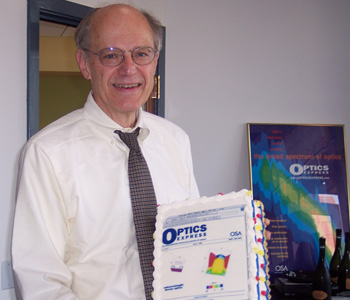President's Message
President's Message

OSA members should know that the Society has quietly celebrated a small anniversary this summer. July marked the 10th year of publication of Optics Express. It’s now ranked first, according to the ISI Impact Factor listing, among the top 50 journals in optics. When it was proposed in 1994, it was seen as a bold experiment. Over the next two years, it was predicted to be a takeoff doomed to crash.
But in 1997, it moved from “test bed” to “launch pad,” as past-editor Michael Duncan put it, with procedures in place that have become accepted standards for all-electronic open-access journals in the physical sciences.
Members of the original ad hoc Development Committee were T.M. Baer, J.E. Bjorkholm, J.A. Giordmaine, A. Johnston, P.L. Kelley, R.L. Shoemaker, and consultants B.P. Stoicheff and John R. Murray. It’s easy to forget how rapidly Internet technology was changing in the mid-1990s. A correct decision at one meeting could become silly before another meeting could be held. At that time, Mosaic was the browser in widest use, but soon Netscape replaced it. We steered clear of the early Internet Explorer because it was so unstable. The one steady techno-hero of the day, solving pressing problems with manuscript acceptance, file submission, and reviewing procedures was of course Adobe’s portable document format, PDF. It made exotic early visions of all-electronic operation realistic and eventually mundane.
Members of my first several panels of Associate Editors were the heroes. They took responsibility for encouraging submissions from reluctant colleagues, hand-holding for authors and reviewers, and managing the Focus Issues that were critical to eventual success. Through the first three volumes they were: David Boas, Thomas Brown, Charles Clark, Michael Duncan, Roger Falcone, Mikhail V. Fedorov, Michael Feit, Bruce Shore and James C. Wyant. If you see one of them, offer congratulations and thanks for a job well done.
I guess everybody knows that OpEx is fully successful now, after a fitful first five years, followed by an explosion in submissions that was artfully guided by Mike Duncan, and now continues under Martijn de Sterke. Rather than quote statistics, I think it’s more fun to hear what it was like behind the scenes. Here’s an excerpt from an early memo I sent to the Ad Hoc Committee and to Ghassan Rassam, OSA Director of Publications. We were struggling with an early e-server called OpTiX (before the name Optics Express had been invented):
“The OpTiX e-server … is supposed to provide a test for an e-journal. If you have tried to reach OpTiX on Mosaic http://www.osa.org, you know that we are well behind schedule. As this is written OpTiX is almost on the verge of running properly … the OSA computer system itself has been operating erratically … re-boots have repeatedly cancelled the password of the outside part-time software developer … his new full-time job prevents him spending much consecutive time on OpTiX … the original schedule … was not realistic … on the basis of statements made about the “presently feasible” status of e-server operation which I grossly misinterpreted.”
“For these reasons and others, … more than one “final deadline” was agreed on … and then found impossible to meet for … technical reasons. I’m sorry to report these things, but you should have a realistic picture. … I’m optimistic that we’re nearly on track. A number of volunteers are presently testing the submission system. … Given the better than expected financial performance of OSA in 1994, and OSA’s continuing high-priority focus on electronic publications, I am considering a request for a boosted budget for OpTiX development. We are in the position that $2000-$3000 would make a very big difference.”
I think you can see some of the realities we kept bumping into, and the problems didn’t end when formal operation began. In the first years, getting authors to adjust to our rapid publication schedule was a continuing challenge. One author complained that we ought to change our name to “Optics Warp Speed” upon learning the short time she was given to turn her paper around after review.
If you want to hear really funny stories, you can consult two very special persons we couldn’t have survived without. One is Deborah Herrin, now Senior Director of IT Services at OSA, who was our liaison in OSA management before the Publications Directorate took the journal over. The other is Jennifer Martin, Production Editor steadily since 1998. Jennifer’s tales are from the shop floor and are probably the best.
Log in or become a member to view the full text of this article.
This article may be available for purchase via the search at Optica Publishing Group.
Optica Members get the full text of Optics & Photonics News, plus a variety of other member benefits.
